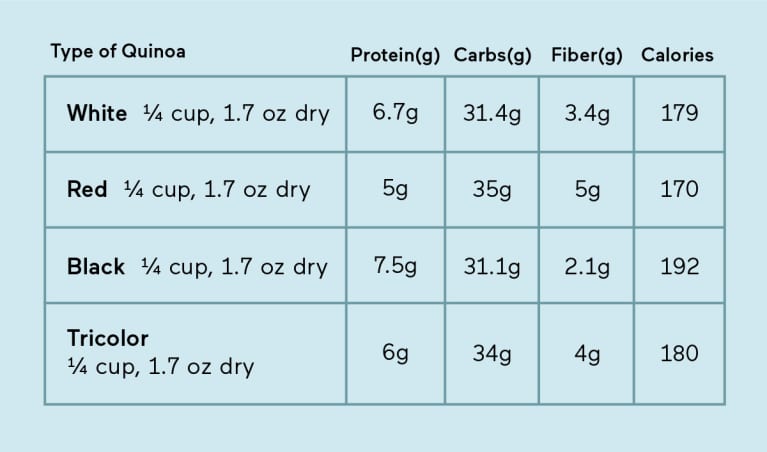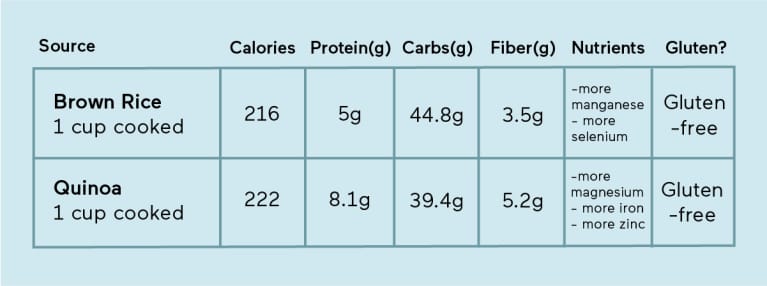What Is Quinoa? Everything You Need To Know About This Super Seed
You've probably seen quinoa on restaurant menus or on the shelves of your favorite health food store, but do you know just how much nutrition is packed into this tiny seed?
Quinoa is a flowering plant in the amaranth family that originated thousands of years ago in the Andes Mountains. It's frequently referred to as the "super grain seed," as it has more protein than any other grain—and it's pretty tasty, too. Here, we break down exactly what quinoa is, who can eat it, and how to make the fluffiest bowl of quinoa every time.
What is quinoa?
Quinoa is a seed that acts like a grain when cooked. It's gluten-free, high in protein, and contains nutrients like vitamin B, fiber, and various minerals (iron, calcium, zinc, and magnesium, to name a few) that boast a myriad of health benefits.
Quinoa also grows in a rainbow of colors—from white to red to black. All the different colors are slightly different in texture, taste, and properties, too:
- White quinoa is the most common quinoa—of all the quinoa varieties, this one has the most delicate taste and the lightest texture. When cooked, white quinoa is fluffier than the other types as well.
- Red quinoa has a richer taste than white quinoa and is slightly chewier, with a heartier and nuttier flavor than white quinoa. Because it's heartier, red quinoa holds up better when cooked and is less mushy than the other varieties (making it a great addition to salads and other mixed meals).
- Black quinoa is a bit more earthy in flavor than white quinoa, and this type is also slightly sweeter as well.
- Tricolor quinoa is simply a blend of all the types of quinoa—together, you get a mixture of the slightly different textures and flavors of all the colors of quinoa.
When cooking these different types, it's best to follow the label’s instructions. But a general rule-of-thumb is to cook based on the timing of the red quinoa, as the white will typically cook quickly (don't worry about overcooking, because the difference in cooking time isn't that large enough to make a real impact on the flavor and texture).
Here's how the different colors compare nutritionally:

Who can eat quinoa?
In short, anyone can eat it. It's gluten-free, keto-friendly, and Mediterranean-diet-approved. But there are some people who follow certain eating plans and should probably stay away from quinoa. Here's the breakdown:
Eating plans that include quinoa:
- Gluten-free diet
- Vegan diet
- Vegetarian diet
- Flexitarian diet
- Anti-inflammatory diet
- Keto (but it would likely take up your entire day of carbs!)
- Mediterranean
- MIND diet
- Nordic diet
- High-fiber diet
Eating plans that don't include quinoa:
- Paleo diet
- Grain-free diet
So, who is quinoa good for?
Quinoa is good for anyone who isn't following an extremely low-carb, paleo, or grain-free diet. Because quinoa is loaded with nutrients and fiber, as well as vegan protein, health experts love to recommend it.
How do you eat quinoa?
Quinoa can be used in many different ways, and it's super easy to make, too. Here's how:
- Rinse the quinoa (unless the bag says that it's rinsed) by soaking the grain in water for 2 minutes to remove the outer shell; then drain the water and add the quinoa to the cooking pot.
- Next add water—it's about 2 cups for every 1 cup of quinoa. Bring the water to a boil, then simmer for 15 to 20 minutes.
- Check to see if it's cooked by making sure that the grain is translucent. If so, it's done; if not, continue to cook for a few more minutes, and keep checking the grain to see if it's soft and translucent. Before serving, allow it to cool, and then enjoy.
You can also cook it in a rice cooker—complete the same steps above, but instead of turning the burner on, click the white rice button or just the start button.
If you don't want to eat all your quinoa right away, you can freeze it for eight to ten months and reheat it anytime you want a quick bowl of quinoa on the spot—freeze it in an airtight container for best results. In the fridge, as with most other foods, store it in an airtight container where it will keep for five to seven days.
Creative ways to eat quinoa:
- As a substitute for rice: Add it to your favorite what-would-be rice dishes, like fried rice, as a side for a meal, instead of rice in stuffed peppers, or in soups.
- Add to thicken up a hearty soup. You can add it even if the recipe for the soup didn't have rice or a grain in it ordinarily—go ahead and add it in. Add desired amount of cooked quinoa to your soup.
- As a breakfast cereal: This is delicious, filling, and easy to assemble. Add cooked quinoa to your favorite milk, blueberries, and nuts, and warm it up!
- As a gluten-free granola: A great addition to your next granola recipe is to add raw quinoa into the mixture along with your nuts and seeds and dried fruit. Bake according to your recipe (about 20 minutes at 350 degrees Fahrenheit is typical).
- Add quinoa to your favorite veggie burger mixture.
- Make quinoa crackers: There are plenty of recipes!
Quinoa vs. rice
Rice and quinoa vary in one fundamental way: One is a grain, and the other is a seed. Beyond that, they also have slightly different nutritional profiles:

The bottom line.
Quinoa is a versatile seed that can be used in so many ways. It's also quite rich in nutrients and lots of flavor. Include this tasty gluten-free seed in your recipes to add flavor, minerals, a complete protein source, and more!
